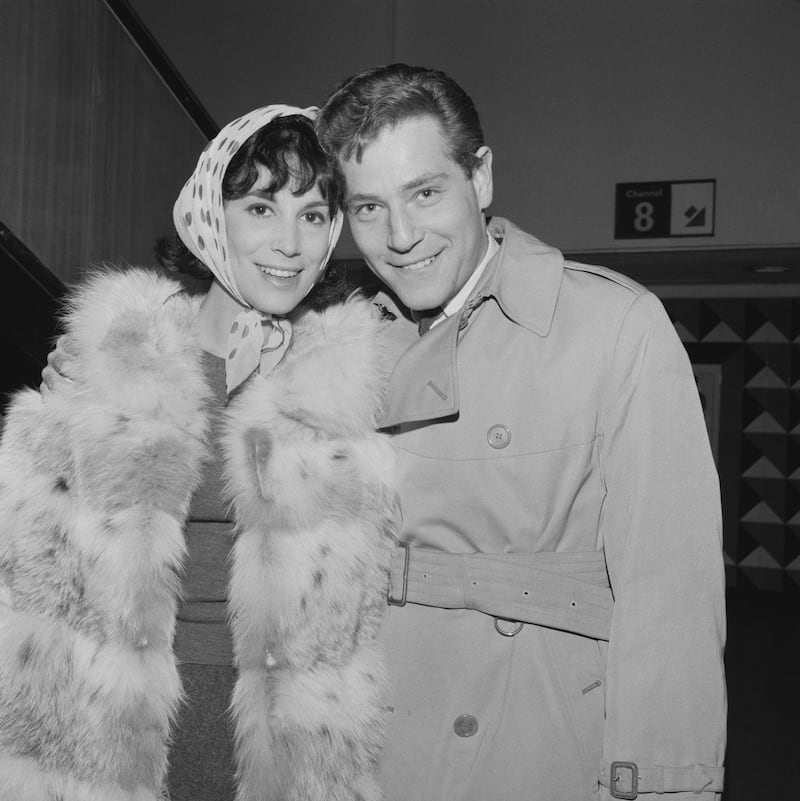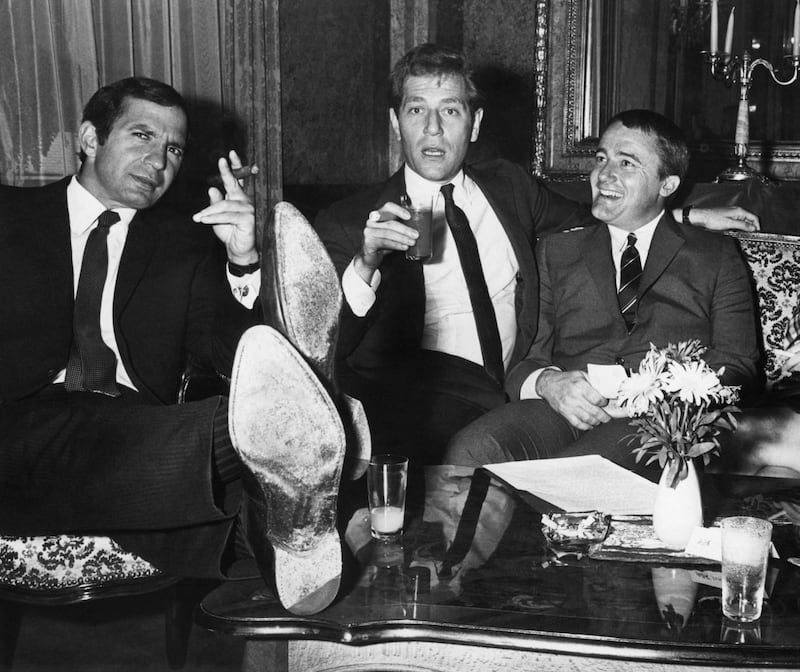George Segal, whose long career began in serious drama but who became one of America’s most reliable and familiar comic actors, first in the movies and later on television, died Tuesday in Santa Rosa, California. He was 87.
The cause was complications following bypass surgery, according to his wife, Sonia Segal, who announced his death. Sandy-haired, conventionally if imperfectly handsome, with a grin that could be charming or smug and a brow that could knit with sincerity or a lack of it, Segal walked a line between leading man and supporting actor.
To younger people, he was best known for his work in comedy ensembles on prime-time network shows, playing the publisher of a fashion magazine on a titillation-fest, Just Shoot Me! and a frolicsome grandfather on a raucous family show set in the 1980s, The Goldbergs.
But decades earlier, when he was a rising young actor, a handful of dramatic roles placed him on the verge of being an A-list star. In 1965 he starred as a conniving American corporal in a Japanese prisoner-of-war camp in King Rat, a grim survival drama based on a novel by James Clavell, leading a cast that included James Fox, Patrick O’Neal, Denholm Elliott and Tom Courtenay.
The same year he played an idealistic painter whose agonizing and probably doomed love affair with a beautiful bourgeois young woman (Elizabeth Ashley) was one of several plotlines in Stanley Kramer’s adaptation of Katherine Anne Porter’s novel Ship of Fools, which places a buffet of class and ethnic conflicts aboard a German passenger ship on a trans-Atlantic crossing in the 1930s.

“He looks real,” Kramer told Life magazine about Segal in 1965, “and he has what John Garfield had. He can draw appeal from an unsympathetic role.” From 1966-68, Segal starred in three dramas adapted for television. In The Desperate Hours, he played Glenn Griffin, an escaped convict who holds a family hostage, a role made famous by Paul Newman on Broadway and Humphrey Bogart in the movies. In John Steinbeck’s Of Mice and Men, he was George, the itinerant farmworker who looks out for his friend Lenny (Nicol Williamson), a childlike behemoth. And he was Biff Loman, the elder son of Willy Loman (Lee J Cobb, repeating his Broadway role), in Arthur Miller’s masterpiece of a warped and failed American dream, Death of a Salesman.
“In the part of Biff, the son who rebels against the hollow dreams of his father,” The New York Times television critic Jack Gould wrote, “George Segal gave a performance of superbly controlled intensity, always modulating the outbursts of rage so that they did not overshadow the young man’s touching anguish.”
In his best-remembered and best-rewarded dramatic role, Segal played Nick, the young husband in Who’s Afraid of Virginia Woolf? (1966), adapted from Edward Albee’s grueling depiction of marital combat. The film, directed by Mike Nichols, famously starred Richard Burton and Elizabeth Taylor as an embittered, longtime campus couple harboring a mutual delusion who, over the course of a long, boozy night in which they entertain a newly arrived biology professor (Segal) and his wife (Sandy Dennis), engage in a scabrous war of words. All four actors were nominated for Oscars, Segal for the only time. (The women won.)
Beginning in the late 1960s, however, Segal’s gift for comedy, especially social satire, redirected the path of his career. He spent most of the decade as a leading man in contemporary roles, generally in films aiming at both humor and poignancy in their observations of romance, marriage, friendship, class and the meaningful life.
In Bye Bye Braverman (1968), directed by Sidney Lumet, he played a public relations man in the throes of contemplating mortality, one of four Jewish intellectuals attending a funeral after the unexpected death of their mutual friend. In No Way to Treat a Lady (1968), an arch thriller, he played a detective being pestered by his mother (Eileen Heckart) to get married as he tracks a mother-obsessed serial killer (Rod Steiger). In Loving (1970), one of his many films in which adultery was a theme, he played a freelance illustrator in career and marital crisis.
'I was a hopeless magician, so I jazzed up the act'
In the 1970s, Segal was among Hollywood’s busiest and most recognizable actors, appearing in films whose comedy and outlook, sometimes strikingly out of whack with today’s sensibility, were characteristic of the decade. He starred with Ruth Gordon in Where’s Poppa? (1970), Carl Reiner’s outlandish and farcical comedy about a man determined to rid himself of his mother; opposite Barbra Streisand as a nebbishy writer involved with a prostitute in The Owl and the Pussycat (1970); and with Robert Redford in a manic crime caper, The Hot Rock (1972).
In Paul Mazursky’s Blume In Love (1973), Segal played the title character, a divorce lawyer whose wife (Susan Anspach) catches him in bed with his secretary, divorces him and takes up with a renegade musician (Kris Kristofferson). The film rather sympathetically traces Blume’s desperate effort to win his wife back, which he manages to do only after getting drunk, raping her and getting her pregnant. (The film treats this as a transgression suitably redressed by a punch in the nose.)
The same year he appeared in A Touch of Class as a married American businessman in London who blithely takes up with a willing divorcee (Glenda Jackson) – the character is way too willing, by today’s lights, to earn the sympathy and admiration the film intends – an affair that begins in high comedy and ends in sadness after the two fall in love and discover that infidelity is terrifically hard to schedule.
In Fun With Dick and Jane (1979), he and Jane Fonda starred as a pair of odd anti-heroes, an affluent married couple whose debt-dependent life together is threatened when he loses his job as an aerospace engineer and they turn to crime to support the budget to which they had grown accustomed. The film, which received generally good reviews, is anachronistic in its good cheer regarding characters within what we now call the 1 per cent, although some reviewers recognized the problem at the time.
“Buried not very deeply within the film there is a small flaw,” Vincent Canby wrote in The New York Times. “We are asked to like and to sympathise with Dick and Jane, played by Mr Segal and Miss Fonda with a fine, earnest kind of intensity I associate with good screwball comedy of the past, and we do like them enormously, even though the characters are completely dedicated to maintain all-wrong values.”
Dick and Jane nonetheless underscored Segal’s strength as a comic actor; he was at his best in give-and-take roles, as a co-star, creating a dynamic partnership with another performer. To wit, perhaps Segal’s most enduring role from that time was in California Split (1974), Robert Altman’s wry, sometimes uproarious and yet naggingly melancholic portrait of a pair of compulsive, and essentially low-rent, gamblers (Elliott Gould was Segal’s compatriot and co-star) trolling for the big score at racetracks, casinos and poker parlors.
'I didn't change my name because I don't think George Segal is an unwieldy name. It's a Jewish name, but not unwieldy'
“Their names are Bill and Charlie, and they’re played by George Segal and Elliott Gould with a combination of unaffected naturalism and sheer raw nervous exhaustion,” critic Roger Ebert wrote in his review. “We don’t need to know anything about gambling to understand the odyssey they undertake to the tracks, to the private poker parties, to the bars, to Vegas, to the edge of defeat, and to the scene of victory. Their compulsion is so strong that it carries us along.”
George Segal Jr was born in New York City on February 13th, 1934, and grew up in Great Neck, on Long Island. His father was a malt and hops dealer; his mother was the former Fanny Bodkin. Young George was a musician – he played trombone as a boy and was proficient enough on the banjo to play in jazz bands in college and afterward – and he performed magic tricks at children’s parties.
“I was a hopeless magician, so I jazzed up the act,” he told Life. “I’d open up with a few fast tricks, then two friends would come on and we’d start throwing shaving-cream pies at each other. The kids would always end up throwing cake at each other and everybody would have a wild time. Of course it was always a one-shot deal and we were never invited back.”
He attended boarding school in Pennsylvania, moved on to Haverford College and eventually graduated from Columbia. He worked in various unpaid jobs (ticket-taker, usher, orange soda vendor) at Circle in the Square, an off-Broadway theater. He eventually appeared there, in 1956, in Eugene O’Neill’s The Iceman Cometh, and married his first wife, Marion Sobel, onstage on a Monday night when the theater was dark. Shortly thereafter he was drafted into the US army.
After being discharged, he followed the aspiring actor’s path, earning roles off-Broadway and gradually prying open the door to the movies and television. He was working with an improvisational troupe called the Premise when he was cast in his first film role, as a young doctor in a 1961 film called The Young Doctors, which starred Ben Gazzara and Fredric March.
He had a small role in the second World War film The Longest Day, and in 1964 he appeared as a swaggery ladies’ man with Brian Bedford in an off-Broadway production of The Knack, a comedy by Ann Jellicoe, directed by Mike Nichols, who had once turned Segal down for a part but would subsequently cast him in Virginia Woolf.

“When he came in to try out for me a few years ago,” Nichols said in 1965, “I saw a kind of arrogance I didn’t want. But I learned he’s not the tough guy he seems to be. What you get with George is masculinity and sensitivity, plus a brain. His conflicting quality ? half rough and half gentle and the mind to control it – gives an element of surprise to whatever he does.”
Segal, whose imperfect nose and Jewish surname made him an unlikely movie star in the 1960s, resisted suggestions that he fix both. “Listen, I don’t think there’s anything better than Cary Grant, the Cary Grant of Bringing Up Baby and The Philadelphia Story,” he said in a New York Times interview in 1971. “And I think one of the best actors today is Robert Redford, and you don’t get much handsomer than that. But I guess I do like the fact that there isn’t so much artifice today.
“I was happy that Cary Grant was Cary Grant rather than Archie Leach” – Grant’s birth name – “but I didn’t change my name because I don’t think George Segal is an unwieldy name. It’s a Jewish name, but not unwieldy. Nor do I think my nose is unwieldy. I think a nose job is unwieldy. I can always spot ‘em. Having a nose job says more about a person than not having one. You always wonder what that person would be like without a nose job.”
Segal’s first marriage ended in divorce. His second marriage, to Linda Rogoff, ended with her death in 1996. He is survived by his wife, Sonia. Details on other survivors were not immediately available.
Segal’s stature as a star diminished in the 1980s, and his career flagged. He appeared in several television movies and returned to Broadway in 1985 for the first time in 22 years, appearing in a role played by Jackie Gleason in the movies – the manager of an aging boxer in Rod Serling’s drama, Requiem for a Heavyweight – but that production closed after just a few performances.
Since then, in addition to his successful television series, Segal appeared in small character roles in several films, including The Cable Guy (1996), a dark comedy with Jim Carrey and Matthew Broderick; The Mirror Has Two Faces (1996), a romantic melodrama directed by and starring Barbra Streisand; Flirting With Disaster, a comedy about a young man searching for his birth parents, with Ben Stiller, Téa Leoni, Patricia Arquette, Lily Tomlin, Alan Alda and Mary Tyler Moore; and Love and Other Drugs (2010), about a volatile love affair between a drug company representative (Jake Gyllenhaal) and a woman with Parkinson’s disease (Anne Hathaway).
He has also appeared in recurring roles on television series including Entourage and Tracey Takes On . . ., about himself in a 1998 New York Times interview. “I keep bobbing up in all sorts of places, although I never know in advance where or when.” – New York Times











